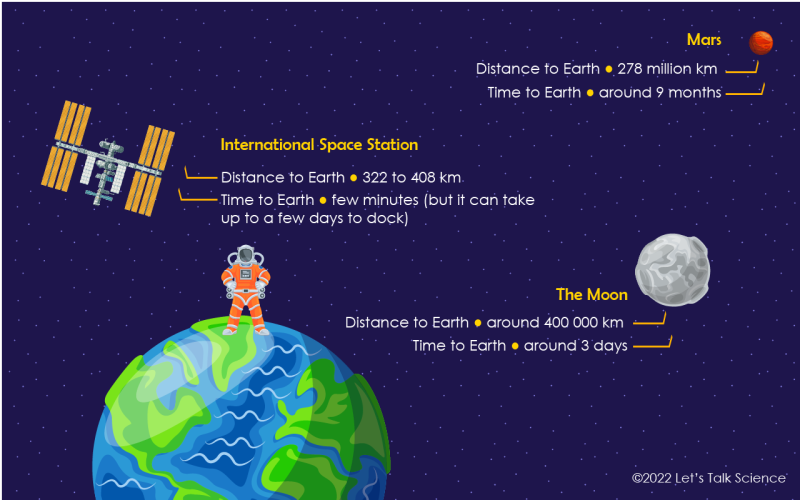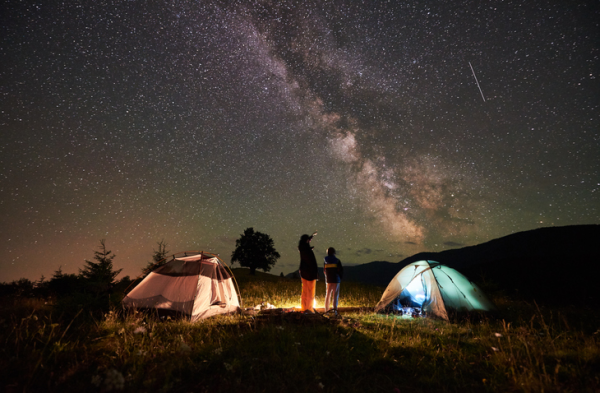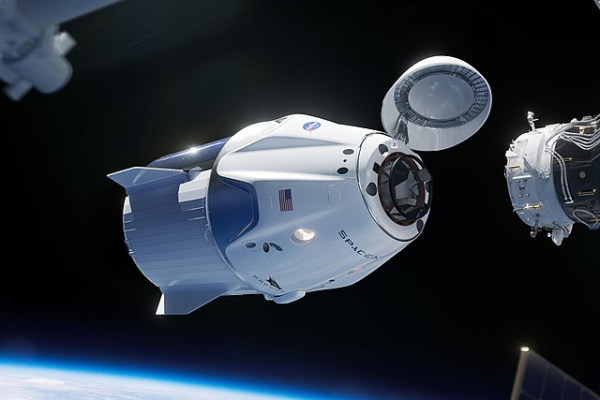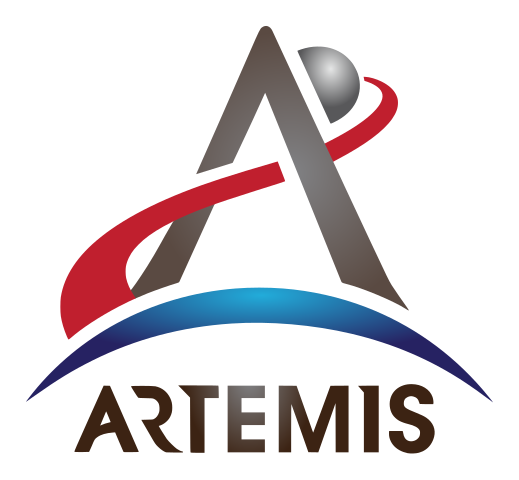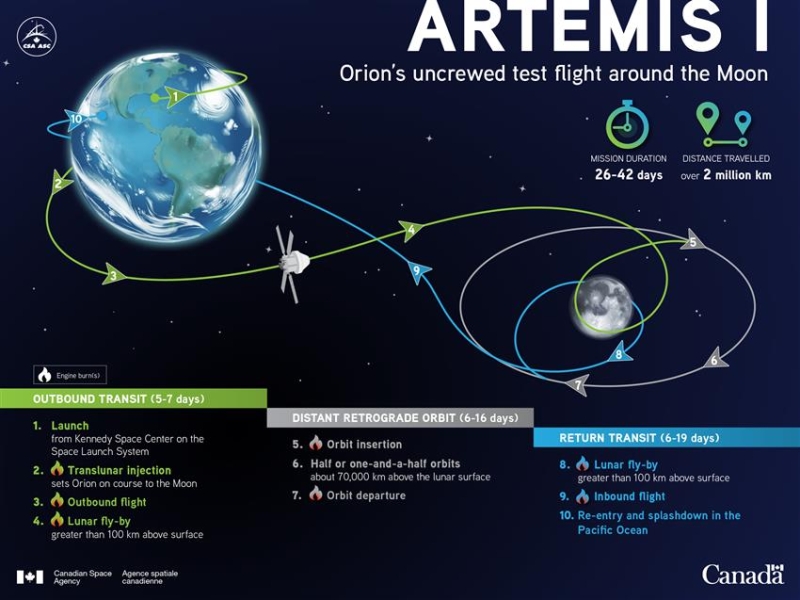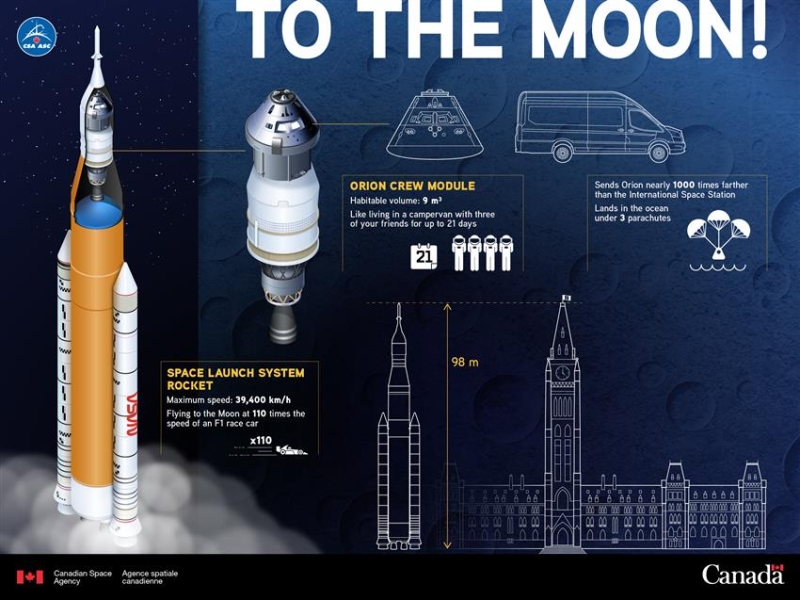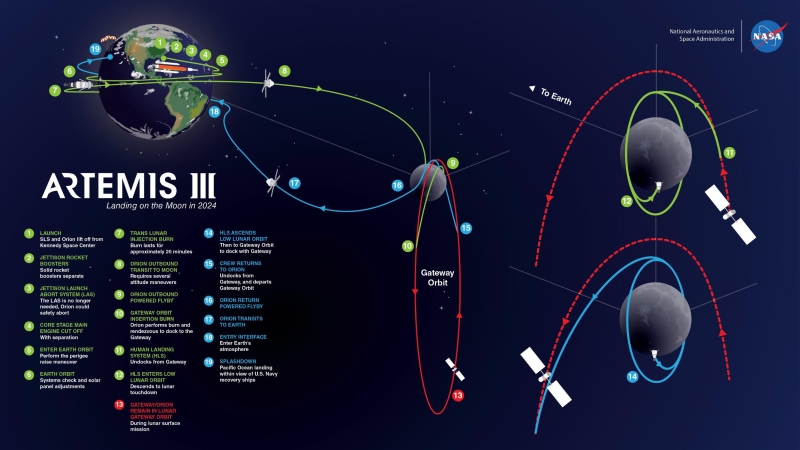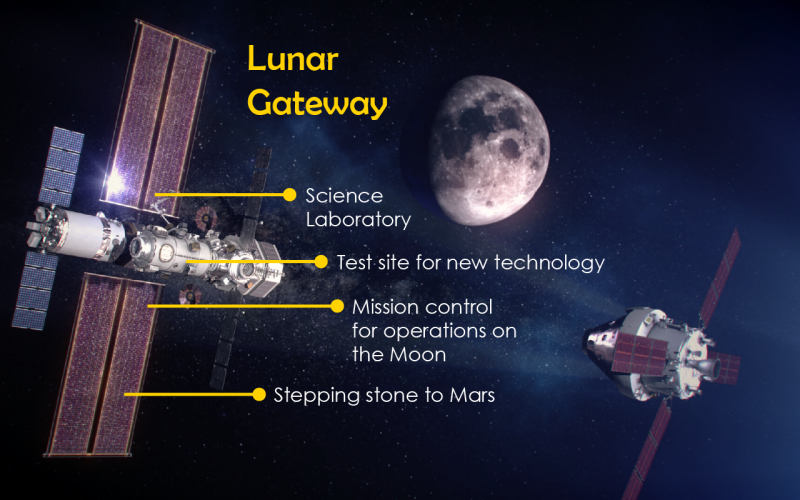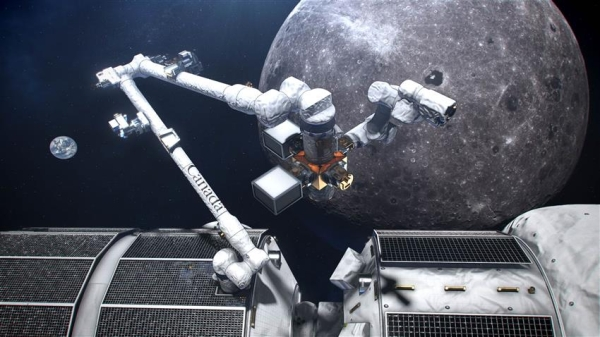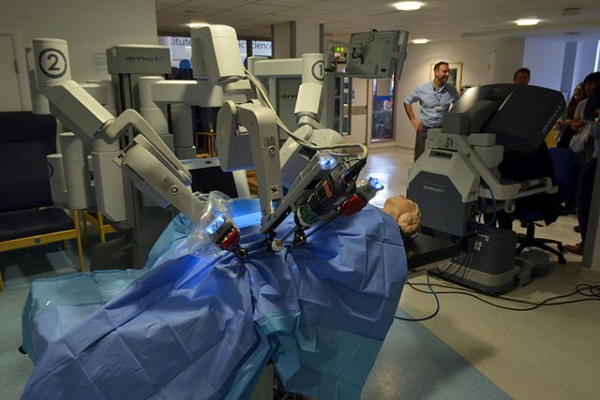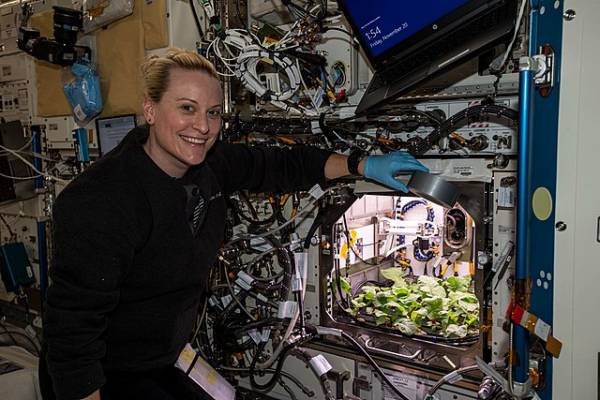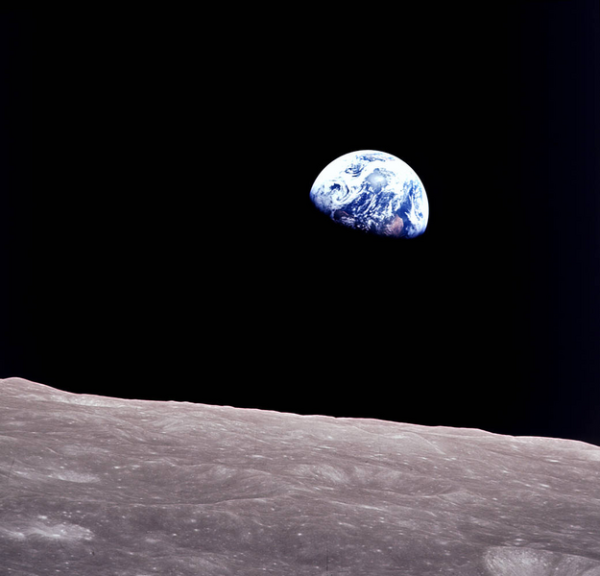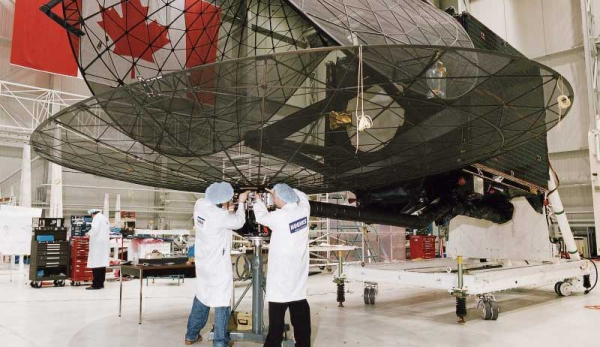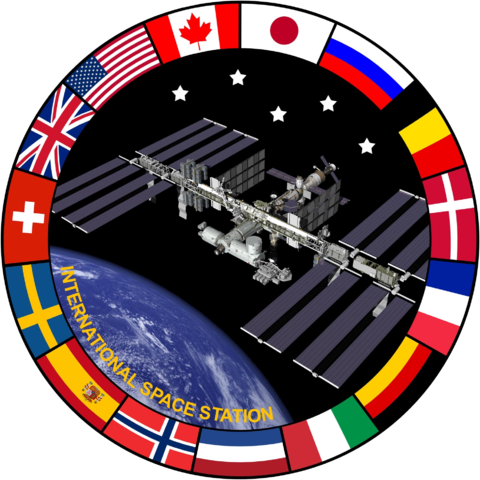Canada Goes to the Moon!

Astronaut stands on the Moon with a Canadian flag (©2022 Let’s Talk Science)

Astronaut stands on the Moon with a Canadian flag (©2022 Let’s Talk Science)
How does this align with my curriculum?
Learn about Canada’s new role in space exploration, what we plan to achieve on and around the Moon.
Canada is getting ready to go to the Moon and it’s going to be an adventure! Let’s find out about Canada’s role in missions to the Moon, and why we’re going there in the first place.
Why go to the Moon?
You may be wondering, why go to the Moon? Haven’t people already gone there?
The first time humans went to the moon were during the Apollo missions between 1969 and 1972. These early missions helped people learn a lot of things. They learned how to make technologies that could get people to space and back safely to Earth. They learned how to survive on the surface of the Moon for a few days. For more information about the history of space exploration, check out this backgrounder on Human Spaceflight.
For the upcoming return to the Moon, humans have a larger goal. They want to learn how to survive in deep space. This includes Mars and beyond! People have lived in space, but only in space stations. Living on the Moon will allow people to develop the skills and knowledge to explore even deeper space.
Image - Text Version
Shown is a colour illustration of an astronaut standing on Earth, with the ISS, the Moon and Mars in the space around. The astronaut is standing at the top of the bright blue and green globe at the bottom left. They have their hands on their hips, one foot on the island of Greenland, and the other in the arctic ocean. They are dressed in an orange space suit and silver helmet. Behind, the background is dark blue with tiny white stars. Above and to the left is a thin, silver, T-shaped object with rectangular gold wings. This is labelled, "International Space Station" in yellow text. Two bullet points are below the label. The first reads, "Distance to Earth - 322 to 408 km." The second reads, "Time to Earth - a few minutes (but it can take up to a few days to dock." Below and to the right is a grey sphere with three large craters. This is labelled, "The Moon" in yellow text. Below the label are two bullet points. The first reads, "Distance to Earth - around 400 000 km." The second reads, "Time to Earth - around 3 days." In the top right corner of the illustration is a small, reddish-orange sphere. This is labelled, "Mars" in yellow text. Below the label are two bullet points. The first reads, "Distance to Earth - 28 million km." The second reads, "Time to Earth - around 9 months."
Imagine you were going on a camping trip to a new place far from home. But you had never gone camping before. What would you do?
First, you might learn about all the gear you need to go camping. Next, you might practice setting up your camping stuff in your own backyard. Then, you might move farther from the security and comforts of your home to a campground nearby.
Image - Text Version
Shown is a colour photograph of a campsite at night, with a streak of bright stars above. Above the campsite, the sky takes up most of the photograph. It is dark and crowded with stars. A bright, billowy, wide streak stretches from the horizon to the top edge of the image. The centre of the streak is dark, and both edges look like mottled cloud. It glows in white, golds, pinks and purples. These colours spread to the horizon, whereseveral trees and a low hill are silhouetted against the sky. At the bottom of the photograph are two tents. The one on the right is lit from inside, and glows blueish green. The one on the left is cream coloured. The grass around the tents is illuminated by a campfire in between them. Two people stand in front of the fire. On the left, a tall person is pointing up to the sky. On the right, a shorter person is looking in that direction. They are both dressed in dark, hooded coats.
Canadian astronauts are now quite confident travelling, living and working on the International Space Station (ISS). The ISS is the closest outpost to Earth. Living on the ISS is a little like camping in your backyard.
The Moon is our next closest destination. It’s kind of like camping in a nearby campground.
We can only really learn how to live in space by going there. And going to space is now easier than it has ever been. Both governments and private companies, like SpaceX, are sending people to space on a regular basis. This idea would have been science fiction 50 years ago.
Image - Text Version
Shown is a colour photograph of a pointed cylindrical object in space, above the Earth, near a smaller cylinder. The object is horizontal and gleaming white against black space. The bottom half is a ribbed cylinder with with two small fins visible. The top half is a slightly wider cone shape. The point of this cone has a round door that has been lifted open. Inside, is a smaller, black ring. This ring is lined up with another cylindrical object, at the left edge of the photograph. This object has a white ring at the front, and a darker area, covered with wiring, at the back. Below, a corner of a blue, gridded solar panel is just visible at the bottom edge of the photograph. In the top left corner, there is another white structure, out of focus. It looks flat, with a large bolt. These three structures are the only parts of the space station visible in the image. The space around the capsule is deep black and featureless. Below, the curve of the Earth is just visible. It is clouded white and topped with a thin strip of bright, rich blue that disappears into the black.
Water: A Crucial Resource
Humans need water to survive. Just like when you go on a camping trip, you have two options for your water supply. You can bring it with you, or find some once you get there. Astronauts have had to bring their water with them for every journey to space in the past. But to live on the Moon or Mars for a long time, they need to be able to find water in space.
Astronauts need water to stay hydrated, but they can also use it to grow food. They can turn it into oxygen to breathe. They can even turn water into fuel for rockets or for generating electricity.
Scientists have used satellites to confirm there is frozen water on the Moon. Most of these ice deposits are at the Moon’s South Pole. This is why the next missions to the Moon are going to the lunar South Pole.
International Collaboration for Space Exploration
In October of 2020, Canada signed an international agreement called the Artemis Accords. This agreement includes over twenty countries that have pledged to work together for the peaceful exploration and use of the Moon, Mars, and other astronomical objects.
Space agencies and companies from Canada, the United States, Japan, and the European Union are working together to travel to the Moon by participating in the Artemis program. The Canadian Space Agency (CSA) is part of this program, which is led by NASA.
Image - Text Version
Shown is a colour illustration of the Artemis program logo. It is a stylized capital letter A on a curved blue crescent with the word Artemis underneath. The line across the centre of the A is a long red strip that curves up from the left side of the crescent, through the middle of the letter, to a grey sphere behind its pointed top.
The main goal of the Artemis program is to prepare for humans to stay on the Moon by 2025. Several missions are planned for the program.
These are the first three:
Artemis I
This is a test flight of the Orion spacecraft and the Space Launch System (SLS) rocket. There were no astronauts on board. The mission launched on November 16th, 2022 and returned December 11, 2022.
Image - Text Version
Artemis I: Orion's uncrewed flight around the Moon – infographic
The infographic includes a representation of Earth, the Moon, and the Orion spacecraft. A curvy line marks the expected flight path of the mission. Ten arrows along the flight path indicate Orion's direction. The arrows are numbered to correspond to the following steps.
- Outbound transit (5 to 7 days)
-
-
Step 1: Launch from Kennedy Space Center on the Space Launch System.
-
Step 2: Translunar injection sets Orion on course to the Moon. This step will involve one or more engine burns.
-
Step 3: Outbound flight. This step will involve one or more engine burns.
-
Step 4: Lunar fly-by greater than 100 km above surface. This step will involve one or more engine burns.
-
- Distant retrograde orbit (6 to 16 days)
-
-
Step 5: Orbit insertion. This step involves one or more engine burns.
-
Step 6: Half or one-and-a-half orbits about 70,000 km above the lunar surface.
-
Step 7: Orbit departure. This step involves one or more engine burns.
-
- Return transit (6 to 19 days)
-
-
Step 8: Lunar fly-by greater than 100 km above surface. This step involves one or more engine burns.
-
Step 9: Inbound flight. This step involves one or more engine burns.
-
Step 10: Re-entry and splashdown in the Pacific Ocean.
-
On the infographic, it says that the mission duration will be 26 to 42 days, and that the distance travelled will be over 2 million kilometres.
Artemis II
This will be the first crewed mission to the Moon since 1972. There will be four astronauts on board, including one from Canada. This means Canada will be only the second country to have an astronaut fly around the Moon!
Image - Text Version
To the Moon! – Infographic
Infographic showing illustrations and facts about the SLS rocket and the Orion Crew Module that will bring astronauts to the Moon.
- Space Launch System rocket
-
-
Flying to the Moon at 110 times the speed of an F1 race car
-
Height: 98 m
-
Maximum speed: 39,400 km/h
-
Sends Orion nearly 1000 times farther than the International Space Station
-
- Orion Crew Module
-
-
Like living in a campervan with three of your friends for up to 21 days
-
Habitable volume: 9 m³
-
Astronaut height: 1 m 47 cm to 1 m 96 cm
-
Lands in the ocean under 3 parachutes
-
Estimated date: 2024
Artemis III
Four astronauts will travel to the Moon. It is expected that this crew will include a woman and a person of colour.
If all goes well, two astronauts will go down to the lunar surface.
Estimated date: 2025
Image - Text Version
Shown is a colour infographic illustrating the Artemis three mission between the Earth and the Moon.
In the top left corner is an illustration of the Earth. Below and to the right is an illustration of the Moon. Along the right side of the image are two more, closer views of the Moon. Routes to and from the Moon, and orbits around the Moon are illustrated with green, blue, and red lines, labelled with numbered circles in the same colours, from 1-19. These numbers appear in a list below.
Numbers 1-7 loop around the Earth, side-by-side along a green line. These read: "1. SLS and Orion launch from Kennedy Space Center." "2. Solid rocket boosters separate." "3. Launch abort system no longer needed." "4. Core main stage engine shuts off." "5. Enters Earth orbit." "6. Check of systems and solar panels in Earth orbit." "7. Injection burn (20 minutes)."
Next, the green line stretches out into space. This is labelled, "8. Orion outbound travel to Moon." The line arcs over the top of the Moon and ends when it meets a long red oval line. This is labelled, "9. Orion outbound powered flyby," and "10. Orion performs burn and rendezvous to dock to the Gateway.
The green line appears again in the first close-up view of the Moon. This line starts in space to the right of the Moon and loops one and a half times around it. This is labelled, "11. Human Landing System (HLS) undocks from the Gateway." And closer to the surface, "12. HLS enters low lunar orbit and descends for lunar touchdown."
The next number on the list is red. It reads, "13. Gateway and Orion remain in orbit during lunar surface mission." This corresponds to the long, red oval line around the Moon. The moon sits at the top, narrowest part of the oval.
The remaining numbers are blue. Number 14 corresponds to a blue line leading from the red oval, down to a closer loop around the Moon. This is labelled, "14. HLS ascends to a low lunar orbit then Gateway orbit to dock with Gateway."
The blue line continues in the wider view of the Moon and Earth. This line leads from the red oval, down closer to the lunar surface, over the top of the Moon and out into space. This is labelled, "15. Crew returns to Orion then Orion undocks and departs from Gateway," "16. Orion return powered by flyby," and "17. Orion transits to Earth.
Finally, the blue line loops around the Earth and ends over the ocean. This is labelled, "18. Orion enters Earth's atmosphere," and "19. Orion splashes down in the Pacific Ocean."
The Lunar Gateway
As part of the Artemis program, scientists will build a new space station to orbit around the Moon. This station is called The Lunar Gateway, or The Gateway.
Did you know?
The Lunar Gateway will be about one sixth the size of the ISS.
Four astronauts will be able to live and work on The Gateway for up to three months at a time. They will take trips to the surface of the Moon for research, and to test new technologies. Astronauts could also use these trips to prepare for deeper-space missions, like going to Mars.
Image - Text Version
Shown is a colour illustration of a T-shaped object in space, with a list of its functions.
The object is labelled Lunar Gateway in large yellow letters. Below the title are four bullet points. The first reads, "Science Laboratory." The second reads, "Test site for new technology." The third reads. "Mission control for operations on the Moon." The third reads, "Stepping stone to Mars."
The object is made up of two cylindrical sections stacked together as the central stem. One is silver and the other is white. The white sphere is topped with a pair of shiny blue wings, forming the line across the top of the T. These are rectangular and made up of gridded panels. A pair of much larger wings is attached at the join between the two cylindrical sections. Each wing is made up of two long strips of mottled purple and gold material.
The background, the moon is half in shadow at near the top of the illustration. In the bottom right corner another object floats in space. It is made up of a cone shaped structure with a cylindrical base, bracketed by long brown wings. This object is not labelled.
Canadarm3
Unlike the ISS, The Lunar Gateway will not have a crew all the time.
When no one is home, a smart robotic system called Canadarm3 will manage operations autonomously. Canadarm3 will use artificial intelligence to learn from its environment and its experiences.
The Canadarm3 will have one long arm and one short arm. It will also have a set of detachable tools. This means it can do many important jobs.
It will be able to grab and move around visiting space vehicles and The Gateway.
It will also give astronauts a hand during spacewalks.
When it’s not doing these things, it will be inspecting and repairing the station - without help from people on Earth!
Image - Text Version
Shown is a colour illustration of a long mechanical arm extending from a cylindrical object above the moon. In the centre of the illustration is an arm made from two sections of white tubing connected by a flexible joint. The lower section is a bit longer than the upper one, and it's bent at the joint, like an elbow. The word Canada is printed in large black letters along the lower section. Several objects are mounted to the end of the upper section. These include two spheres, two cubes and several cylinders, attached to a central, cylindrical, metallic structure. This end of the arm is framed by the Moon , which takes up half the background. The surface is clear and detailed, in shades of white and grey. The rest of the background is black. The earth is a tiny blue, green and white sphere to the left of the arm. The bottom of the arm is mounted to the curved surface of a large cylindrical object, covered in solar panels.
Engineers and scientists began designing Canadarm3 in 2014, and they plan to launch it in 2027. MDA, an engineering company based in Brampton, Ontario, is leading the development. By the time Canadarm3 is launched, hundreds of Canadian companies will have been involved in its development.
Exploring the Lunar Surface
The CSA created the Lunar Exploration Accelerator Program (LEAP) to support innovation in lunar and deep space exploration. This program helps Canadian organizations to:
- develop and design science experiments for lunar conditions;
- invent new technologies for use in lunar orbit, and on the Moon's surface;
- and begin developing the technologies needed for future deep space missions.
An important part of the LEAP program is supporting the development, launch, and use of a Canadian lunar rover. The Canadian company Canadensys Aerospace Corporation was selected to build the lunar rover. It will have six science instruments to collect data about the surface of the Moon. The plan for the Canadian rover is to gather images, measurements, and data at the Moon’s South Pole no earlier than 2026.
Did you know?
Canada has a long history of developing rovers for space? Learn more about Canada’s rovers.
It is important to send more rovers onto the surface of the Moon. Rovers can explore the area before humans arrive, and teach us what to expect. Learn more about the challenges of designing a rover mission through the Lunar Rover Research Challenge.
Did you know?
China launched the Yutu 2 in 2018.
Space Exploration Benefits Life on Earth
Space exploration impacts our society on Earth in many different ways. Here are some examples.
Healthcare
- Monitoring devices developed for astronauts can be used here on Earth
- Robotic surgery technology is based on the Canadarm2
- Remote health care techniques, like telemedicine, give people more access to doctors
Image - Text Version
Shown is a colour photograph of three mechanical arms reaching over a model of a patient on a surgical table. Each arm is made of several beige sections that get smaller and smaller. These are separated by joints that rotate in multiple directions. At the end of each arm is a tool. These are topped by pale blue lights, and end in long, black rods. These rods are inserted through small holes in a blue surgical sheet. On the right side of this sheet, a beige model of a human head can be seen on a black padded table. In the background, on the right, three people look at a large grey rectangular cube. One person is smiling, with their hands on their hips.
Food Production
- Growing food in extreme environments is both a challenge for deep space missions as well as for Northern communities in Canada. Improvement in such technology can increase food access across the country.
- Studying microbiology in space also prevents food from spoiling before crews are ready to consume it, and helps us understand how to keep astronauts healthy in space.
Image - Text Version
Shown is a colour photograph of a person next to a brightly-lit cabinet filled with plants. The cabinet is built into a white metal wall covered in cables and wiring. It has a square opening with an arched top and a handle at the lower edge. Inside the cabinet is much brighter than the room outside. The plants are bright green and densely packed across the bottom of the cabinet. The person is smiling at the camera, and holding a roll of silver duct tape at the top of the opening. They are wearing a black sweater, and have blond hair pulled back into a bun.
Earth Observation
- Canada uses satellites and radar technology for national security, to monitor resources and the health of the climate, for navigation, and to protect ourselves from natural disasters
- Earthrise was one of the first colour photographs of the Earth in space. For the first time, humans could see how small and fragile our planet is. The environmental movement was just beginning then, and this photograph helped people realize how important it was. The very first Earth Day took place less than two years later, on April 22, 1970.
Image - Text Version
Shown is a colour photograph of the Earth rising over the surface of the Moon. In the centre of the photograph, the Earth is small in deep, black space. But it is the brightest part of the image. A rich blue marble with swirling white clouds. About a third of the globe is in black shadow. The photograph is taken from the surface of the Moon, looking up at the Earth. The ground near the camera is mostly flat, in shades of grey, brown, and beige, with several craters and ridges. The horizon is slightly curved, about a third of the way up the image.
Employment
- About 22 000 people have jobs in the space sector in Canada. This number is expected to increase with the start of the Artemis missions
- The Canadian space industry offers many diverse careers
- In 2018, total revenues in the Canadian space sector reached $5.7 billion
Image - Text Version
Shown is a colour photograph of two people working at the bottom of a huge dish-shaped object. The object is made from translucent black mesh over a curved geodesic structure that stretches across the image. Two people in white coats stand underneath the bottom centre point of the dish, on either side of a grey pole holding it up. Two more, similar objects are visible, at different angles, above the first. They appear to be attached with black metal arms, to a large, black, cube shaped object on wheels. In the background, a third person stands next to two large toolboxes on wheels. The room around is vast and white, with tall ceilings, like an aircraft hanger. A large Canadian flag hangs on the back wall.
Partnerships with other Countries
- Space exploration brings people from different nations together, to work peacefully towards a common goal
- By working together, nations develop valuable expertise. Canada has become a world leader in space robotics.
Image - Text Version
Shown is a colour illustration of a round emblem with a photograph of the ISS surrounded by a border of flags. The photograph in the centre shows an object with two long rectangular sets of solar panels, like wings, attached by a long pole with a T-shaped arrangement of cylinders in the centre. Below, the curve of the Earth's surface is visible. The title "International Space Station" curves in yellow letters across the globe. Above the ISS, five white stars are arranged against the black space. The border around the photograph is made up of fifteen different national flags.
Learn More
Objective Moon (Activities and Resources)
This is a collection of Moon themed Youth and Educator resources and activities from the Canadian Space Agency. The curriculum based resources also includes funding opportunities, photos and videos.
Do You Know What it Takes to Become an Astronaut? (2017)
This quiz from the Canadian Space Agency is designed to help students understand the requirements and conditions to becoming a Canadian astronaut.
First Canadian rover to explore the Moon (2024)
This is information by the Canadian Space Agency about the Canadensys lunar rover
Drive a Space rover (2022)
Explore Mars: A Mars Rover Game is provided by NASA Science Space Place. The game is played by sending a sequence of commands to the Mars rover to collect data during its 8 expeditions. The voice of the game is Charlene Valerio, a NASA/JPL engineer who worked on the real Mars 2020 mission.
Getting Ready to Explore the Moon | Northrop Grumman and NASA's Lunar Gateway Program (2022)
This video features Rick Mastracchio, a former astronaut, as he talks about NASA's Lunar Gateway, including work on the Habitation and Logistics Outpost—humanity’s first home away from Earth as we begin to explore the Moon and the rest of our solar system with the Artemis program. (2:06 min)
How We Are Going to the Moon (2019)
This video from NASA describes using the lunar surface as a proving ground for living on Mars, the Moon is the next chapter in space exploration. (5:31 min)
To the Moon, Canada! (2022)
This information from the Canadian Space Agency outlines Canada’s role and contributions in the upcoming Artemis missions. Learn about our connection to the Lunar Gateway and Canadian rovers.
References
Canadian Space Agency. (2022). Canada’s Role in Moon Exploration.
Canadian Space Agency. (2020, Dec. 11). Everyday Benefits of Space Exploration.
Canadian Space Agency. (2020, Oct. 26) A Framework for Future Space Exploration Activities.
Canadian Space Agency. (2019, March 18). Space Strategy For Canada 2019.
Canadian Space Agency (2024). First Canadian rover to explore the Moon.
Jones, A. (2022, March 8) China's Yutu 2 rover beams back stunning image after 3 years on Moon's far side. Space.
Let’s Talk Science (2021, Dec. 14) Nadeem Ghafoor at Let's Talk Lunar.[Video]. YouTube.
Let’s Talk Science (2021, Dec. 14) Tim Haltigin at Let's Talk Lunar [Video]. YouTube.
NASA. (2013, May 20). How Long Does it Take to Get to the ISS?. [VIdeo]. YouTube.
NASA. (2020). The Artemis Accords.
NASA (2021). Artemis Overview.
NASA. (2022). NASA Artemis I Press Kit.
Tillman, N.T. and Dobrijevic, D. (2022, Jan. 20) How Long Does it Take to Get to Mars?. Space.
